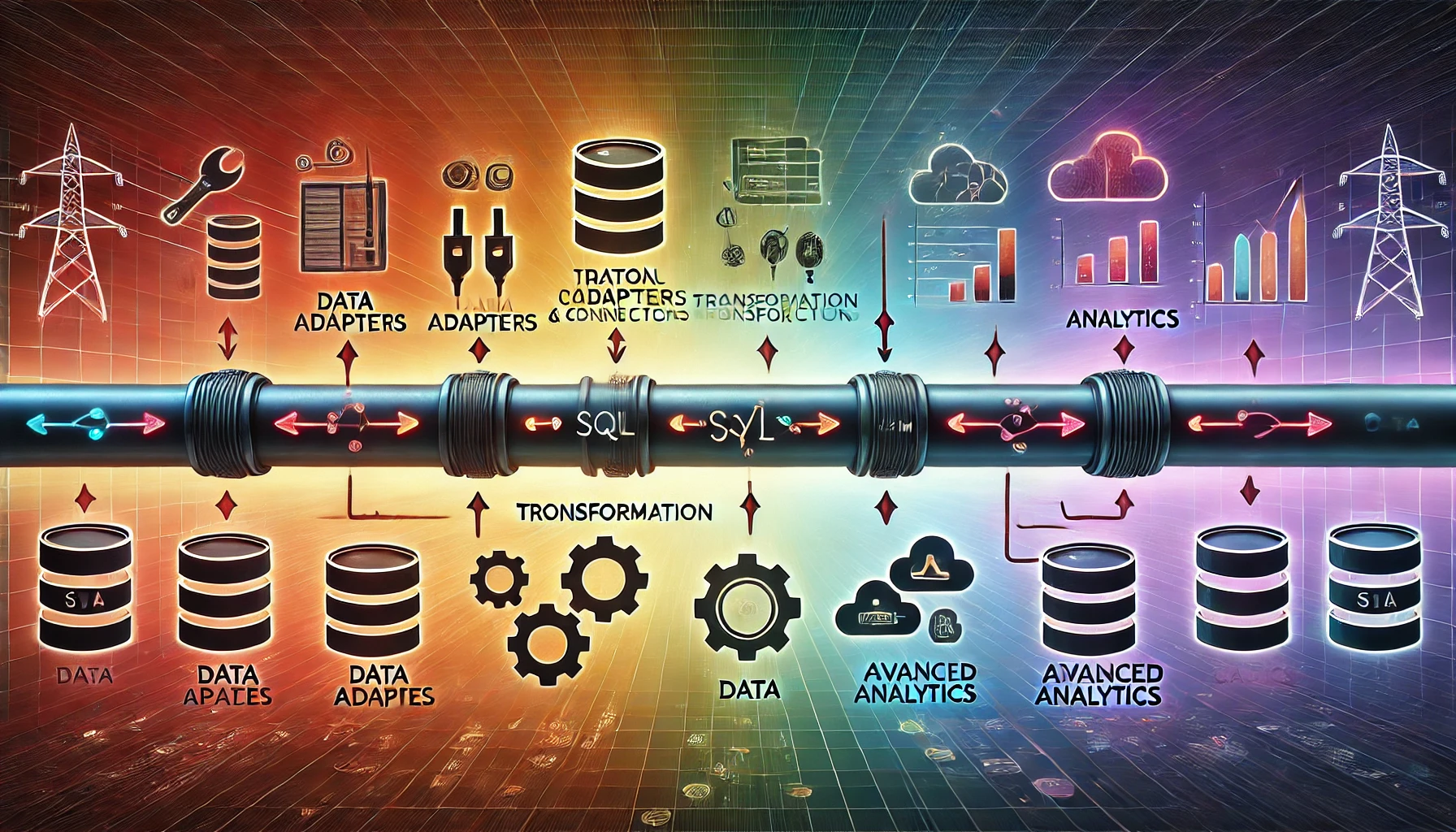The Modern Data Engineer's Journey
 Marc Greenberg
Marc Greenberg
By Marc J. Greenberg, Seasoned Software Professional
and Former Chief Architect at iWay Software
Introduction
The world of data has transformed dramatically over the past few decades. As someone who has been deeply involved in this evolution—particularly during my tenure as the chief architect at iWay Software, I've witnessed firsthand how the foundational principles of enterprise integration have paved the way for modern data engineering. This blog post explores the intriguing parallels between yesterday's integration developers and today's data engineers, shedding light on how the enterprise service buses (ESBs) of the past have evolved into the data pipelines that are crucial to businesses today.
The Roots: Enterprise Integration and ESBs
In the early days of enterprise computing, organizations grappled with the challenge of making disparate systems communicate effectively. This led to the development of Enterprise Service Buses (ESBs) middleware solutions that acted as the backbone of enterprise integration. At iWay Software, we built data adapters and a Java-based integration broker known as the iWay Service Manager. Our ESB facilitated seamless data flow through channels, resembling the data pipelines prevalent in today's architectures.
Key Characteristics of ESBs:
Centralized Communication Hub: ESBs served as a single point of integration for various enterprise applications.
Data Adapters: Custom-built connectors enabled communication between different systems and data formats.
Synchronous Data Exchange: Focused on real-time, transactional data movement to support immediate business processes.
The Emergence of Data Engineering
Fast forward to today, and we see the rise of the data engineer a role that has become indispensable in the era of big data and analytics. Data engineers design, build, and maintain data pipelines that collect, process, and store vast amounts of data for analysis and machine learning applications.
Key Responsibilities of Data Engineers:
Building Scalable Data Pipelines: Handling both batch processing and real-time data streams.
Managing Big Data Technologies: Utilizing tools like Apache Spark, Hadoop, and cloud-based data platforms.
Ensuring Data Quality and Governance: Implementing practices to maintain data integrity across systems.
Parallels Between Integration Developers and Data Engineers
Despite technological advancements, the core objectives remain similar:
Data Movement and Transformation:
Then: Integration developers focused on moving data between enterprise systems using ESBs.
Now: Data engineers build pipelines to transfer data from various sources into centralized repositories for analysis.
Problem-Solving Skills:
- Both roles require analytical thinking to design efficient data flows and troubleshoot issues.
Technical Proficiency:
Then: Proficiency in languages like Java and understanding of SOA (Service-Oriented Architecture).
Now: Skills in Python, Scala, and familiarity with distributed computing frameworks.
Evolution of Technologies
From Monolithic ESBs to Distributed Pipelines:
Scalability Challenges: ESBs often became bottlenecks due to their centralized nature.
Modern Solutions: Adoption of microservices and distributed systems allows for horizontal scaling and improved fault tolerance.
Advancements in Data Processing:
Data Volume and Variety:
Then: Primarily structured, transactional data.
Now: Handling unstructured and semi-structured data from diverse sources.
Processing Paradigms:
Then: Synchronous, real-time processing.
Now: A blend of batch and stream processing to accommodate different data needs.
Data Wrangling: The Art of Preparing Data for Insight
One of the most time-consuming yet vital tasks in the data lifecycle is data wrangling the process of cleaning, structuring, and enriching raw data into a desired format for better decision making in less time. As data sources have become more varied and voluminous, the importance of efficient data wrangling has grown exponentially.
The Role of Data Wrangling in Data Engineering
In today's data engineering landscape, data wrangling is not just about cleaning data; it's about making data usable:
Handling Diverse Data Sources: Data engineers deal with structured, semi-structured, and unstructured data from APIs, logs, social media, IoT devices, and more.
Ensuring Data Quality: They must identify and correct inaccuracies, inconsistencies, and anomalies to ensure reliable analytics.
Data Transformation: Converting data into formats suitable for analysis, which may involve normalization, aggregation, or encoding.
Parallels with Integration Developers' Data Transformation Tasks
Looking back at the era of enterprise integration:
Data Adapters and Transformation: Integration developers created data adapters that often included data transformation logic to map and convert data between different systems.
Standardization Efforts: They worked to standardize data formats across systems, similar to how data engineers today standardize data for downstream applications.
Handling Data Inconsistencies: Just as data engineers must clean data, integration developers had to address discrepancies between systems to ensure smooth data flow.
Evolution of Tools and Techniques
Then:
Custom Scripts and Middleware: Integration developers relied on custom-coded solutions and middleware capabilities to manipulate data.
Limited Automation: Data transformation tasks were often manual or semi-automated, requiring significant effort.
Now:
Advanced Wrangling Tools: Data engineers have access to sophisticated tools like Trifacta, OpenRefine, and features within platforms like Apache Spark that facilitate data wrangling at scale.
Automation and Machine Learning: Modern tools leverage automation and even machine learning to suggest transformations and detect anomalies.
Scalability: Data wrangling processes can now handle terabytes of data efficiently, a necessity in big data environments.
Challenges and Best Practices
Challenges:
Volume and Velocity: The sheer amount of data and the speed at which it arrives can make wrangling a bottleneck.
Complex Data Types: Unstructured data, such as text, images, and videos, adds complexity to the wrangling process.
Data Lineage and Governance: Keeping track of data transformations for compliance and reproducibility is more critical than ever.
Best Practices:
Incremental Processing: Break down data wrangling tasks into smaller, manageable steps that can be executed and validated incrementally.
Reusable Transformation Pipelines: Create modular pipelines that can be reused across different projects and datasets.
Documentation and Metadata Management: Maintain thorough documentation of data sources, transformation logic, and data schemas.
The Strategic Importance of Data Wrangling
Data wrangling is more than a technical necessity; it's a strategic activity that directly impacts business outcomes:
Accelerating Time to Insight: Efficient data wrangling reduces the time it takes for organizations to derive actionable insights.
Enhancing Data Reliability: Clean, well-structured data leads to more accurate analytics and machine learning models.
Enabling Self-Service Analytics: When data is well-prepared, it empowers analysts and business users to explore data without constant assistance from data engineers.
A Personal Reflection on Data Wrangling's Evolution
During my time at iWay Software, the focus was on creating robust data adapters that could handle the intricacies of system-to-system communication. We often faced challenges with data formats and inconsistencies, which required us to implement custom transformation logic. This experience laid the groundwork for appreciating the complexities of data wrangling today.
As data sources have grown in number and complexity, so too has the need for sophisticated data wrangling. The principles remain the same—ensure that data is accurate, consistent, and ready for use—but the scale and tools have evolved dramatically.
Impact of Cloud Computing
The proliferation of cloud services has significantly influenced data engineering:
On-Demand Resources: Cloud platforms provide scalable resources that can be adjusted based on workload.
Cost Efficiency: Pay-as-you-go models reduce upfront infrastructure investments.
Global Accessibility: Data and services can be accessed from anywhere, facilitating remote collaboration.
Cloud-Native Data Integration:
Serverless Architectures: Allow data engineers to build applications without managing underlying infrastructure.
Cloud Data Warehouses: Services like Amazon Redshift, Google BigQuery, and Snowflake offer scalable data storage and analytics capabilities.
Integration Services: Cloud providers offer built-in tools for data ingestion, transformation, and orchestration (e.g., AWS Glue, Azure Data Factory).
Convergence and Hybrid Roles
The lines between integration developers and data engineers are blurring:
Legacy System Integration: Modern data engineers often need to integrate with legacy systems, requiring knowledge of traditional integration methods.
Emphasis on Data Quality: Both roles prioritize ensuring that data is accurate, consistent, and secure.
Hybrid Skill Sets: Professionals are increasingly expected to have a blend of skills, including software development, data modeling, and knowledge of distributed systems.
Lessons Learned and Best Practices
Drawing from the past offers valuable insights:
Reusable Components: Building modular and reusable data adapters or connectors saves time and reduces errors.
Standardization: Adhering to data standards and protocols ensures compatibility and simplifies integration efforts.
Embracing Change: Staying adaptable to new technologies and methodologies is crucial in a rapidly evolving field.
Documentation: Maintaining thorough documentation aids in troubleshooting and onboarding new team members.
Continuous Learning: The technology landscape is ever-changing; ongoing education is essential.
Conclusion
The journey from enterprise integration to modern data engineering reflects a natural progression driven by technological innovation and changing business demands. Understanding this history enriches our appreciation of current practices and prepares us for future advancements.
Final Thoughts:
As we continue to navigate the complexities of data management, it's essential to recognize the foundational principles that remain constant. Whether you're an integration developer from the past or a data engineer today, the goal is the same: to enable seamless, efficient, and meaningful use of data.
About the Author
Marc J. Greenberg is a seasoned software professional with extensive experience in enterprise integration and data engineering. As the former chief architect at iWay Software, He played a pivotal role in developing innovative solutions that have influenced modern data practices.
Subscribe to my newsletter
Read articles from Marc Greenberg directly inside your inbox. Subscribe to the newsletter, and don't miss out.
Written by
